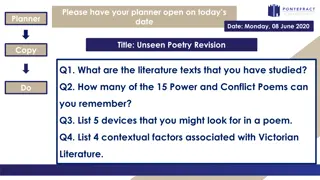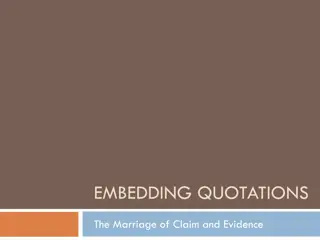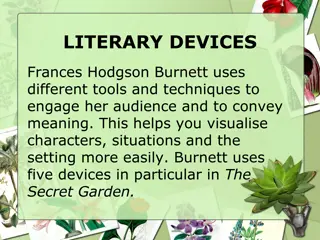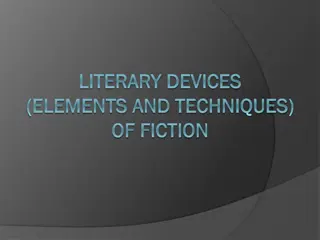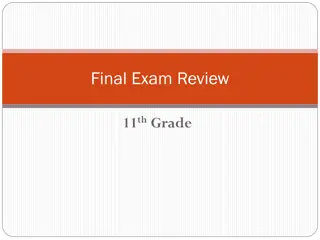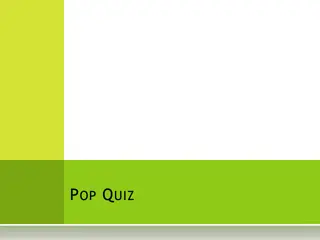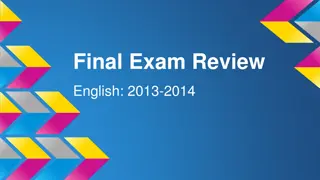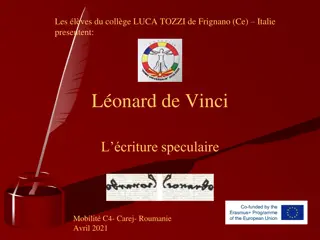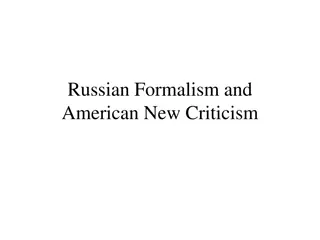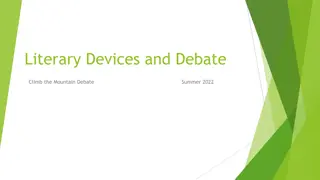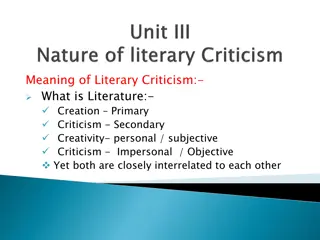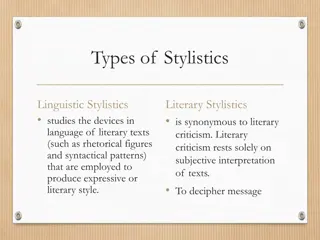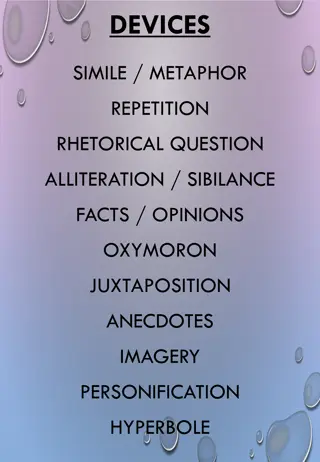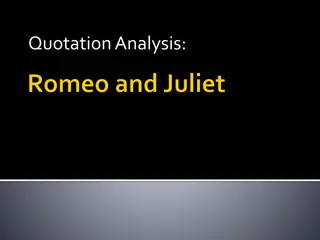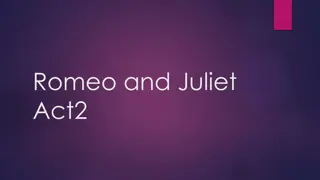Exploring Key Literary Devices in Writing
Literary devices such as foreshadowing, suspense, irony, symbolism, and tone are essential tools that authors use to enhance their writing. Foreshadowing hints at future events, suspense keeps readers engaged, irony adds depth, symbolism conveys deeper meanings, and tone sets the author's attitude. These devices enrich storytelling, creating intrigue and depth for readers.
Uploaded on Sep 13, 2024 | 1 Views
Download Presentation

Please find below an Image/Link to download the presentation.
The content on the website is provided AS IS for your information and personal use only. It may not be sold, licensed, or shared on other websites without obtaining consent from the author. Download presentation by click this link. If you encounter any issues during the download, it is possible that the publisher has removed the file from their server.
E N D
Presentation Transcript
Literary Devices Tools authors use to enhance and enrich their writing
Foreshadowing The literary device foreshadowing refers to the use of hints that set the stage for a story to unfold and give the reader a hint of something that is going to happen without revealing the story or spoiling the suspense. Foreshadowing is used to suggest an upcoming outcome to the story. Example: Poor Ichabod. He would have had a pleasant life if only his path had not been crossed by young Katrina. This hints that things will not turn out well for Ichabod and Katrina, and also alludes to the superstitious nature of the story.
Suspense Suspense is the intense feeling that an audience goes through while waiting for the outcome of certain events. It basically leaves the reader holding their breath and wanting more information. The amount of intensity in a suspenseful moment is why it is hard to put a book down. Without suspense, a reader would lose interest quickly in any story because there is nothing that is making the reader ask, What s going to happen next? In writing, there has to be a series of events that leads to a climax that captivates the audience and makes them tense and anxious to know what is going to happen.
Irony The use of irony in literature refers to playing around with words such that the meaning implied by a sentence or word is actually very different from the literal meaning. In other words, saying one thing and meaning another. Verbal irony sarcasm Ex: What great luck I have! When in fact something bad has happened. Dramatic irony when the reader knows something that a character does not Situational/comic irony when something happens that is comically unexpected Ex: Mugger gets mugged
Symbolism A symbol is literary device that contains several layers of meaning, often concealed at first sight, and is representative of several other aspects, concepts or traits than those that are visible in the literal translation alone. Symbol is using an object or action that means something more than its literal meaning. Example: The phrase a new dawn does not talk only about the actual beginning of a new day but also signifies a new start, a fresh chance to begin and the end of a previous tiring time.
Tone The tone of a literary work is the perspective or attitude that the author adopts with regards to a specific character, place or development. Tone can portray a variety of emotions ranging from solemn, grave, and critical to witty, wry and humorous. Tone helps the reader ascertain the writer s feelings towards a particular topic and this in turn influences the reader s understanding of the story. Example: In her Harry Potter series, author J.K. Rowling has taken an extremely positive, inspiring and uplifting tone towards the idea of love and devotion.
Mood The literary device mood refers to a definitive stance the author adopts in shaping a specific emotional perspective towards the subject of the literary work. It refers to the mental and emotional disposition of the author towards the subject, which in turn lends a particular character or atmosphere to the work. The final tone achieved thus is instrumental in evoking specific, appropriate responses from the reader. Example: In Erich Segal s Love Story, the relationship of the two protagonists is handled with such beauty, delicateness and sensitivity that the reader is compelled to feel the trials and tribulations of the characters.
Dialogue The lines spoken by a character or characters in a play, essay, story, or novel, especially a conversation between two characters. Good dialogue either provides characterization or advances the plot. Example: Brom - I don t know what you see in him. He s got dinner plates where his ears should be, and shovels for feet. This statement to Katrina shows both Brom s jealousy, and some of Ichabod s physical features.
Comparisons-Analogy An analogy is a literary device that helps to establish a relationship based on similarities between two concepts or ideas. By using an analogy we can convey a new idea by using the blueprint of an old one as a basis for understanding. With a mental linkage between the two, one can create understanding regarding the new concept in a simple and succinct manner. Example: In the same way as one cannot have the rainbow without the rain, one cannot achieve success and riches without hard work.
Comparisons -Simile Similes are one of the most commonly used literary devices; referring to the practice of drawing parallels or comparisons between two unrelated and dissimilar things, people, beings, places and concepts. By using similes a greater degree of meaning and understanding is attached to an otherwise simple sentence. The reader is able to better understand the sentiment the author wishes to convey. Similes are marked by the use of the words as or such as or like . Example: He is like a mouse in front of the teacher.
Comparisons -Metaphor Metaphors are one of the most extensively used literary devices. A metaphor refers to a meaning or identity ascribed to one subject by way of another. In a metaphor, one subject is implied to be another so as to draw a comparison between their similarities and shared traits. The first subject, which is the focus of the sentences is usually compared to the second subject, which is used to convey a degree of meaning that is used to characterize the first. The purpose of using a metaphor is to take an identity or concept that we understand clearly (second subject) and use it to better understand the lesser known element (the first subject). Example: Henry was a lion on the battlefield . This sentence suggests that Henry fought so valiantly and bravely that he embodied all the personality traits we attribute to the ferocious animal. This sentence implies immediately that Henry was courageous and fearless, much like the King of the Jungle.
Rhyme The concept of rhythm and rhyme refers to a pattern of rhymes that is created by using words that produce the same, or similar sounds. Rhythm and rhyme together refer to the recurrence of similar sounds in prose and poetry, creating a musical, gentle effect. Example: Used most often in poetry and children s books like those by Dr. Seuss. One fish, two fish; red fish, blue fish.
Alliteration Alliteration is a literary device where words are used in quick succession and begin with letters belonging to the same sound group. Whether it is the consonant sound or a specific vowel group, the alliteration involves creating a repetition of similar sounds in the sentence. Alliterations are also created when the words all begin with the same letter. Alliterations are used to add character to the writing and often add an element of fun to the piece.. Example:The Wicked Witch of the West went her own way. (The W sound is highlighted and repeated throughout the sentence.) Similar tools include assonance (repetition of a vowel sound) and consonance (repetition of a consonant sound)
Connotation vs. Denotation Denotation refers to the use of the dictionary definition or literal meaning of a word. Example: They built a house. In the above sentence, house is meant literally as in a building where a family lives. Connotations are the associations people make with words that go being the literal or dictionary definition. Many words have connotations that create emotions or feelings in the reader. Example: If the word "home" was used instead in the above sentence in place of "house", the meaning would not be so literal as there are many emotions associated with the word "home" beyond simply the structure where people live.
Pun Puns are a very popular literary device wherein a word is used in a manner to suggest two or more possible meanings. This is generally done to the effect of creating humor or irony or wryness. Puns can also refer to words that suggest meanings of similar-sounding words. The trick is to make the reader have an ah! moment and discover 2 or more meanings. Example: Santa s helpers are known as subordinate Clauses.
Idiom or figurative language Figurative language is language that uses words or expressions with a meaning that is different from the literal interpretation. An idiom is an expression used by a particular group of people with a meaning that is only known through common use. Examples: I m just waiting for him to kick the bucket. (To die.) "She has a bee in her bonnet. (An idea in her head that she can t get rid of) The apple doesn t fall far from the tree. (Kids are like their parents.)





